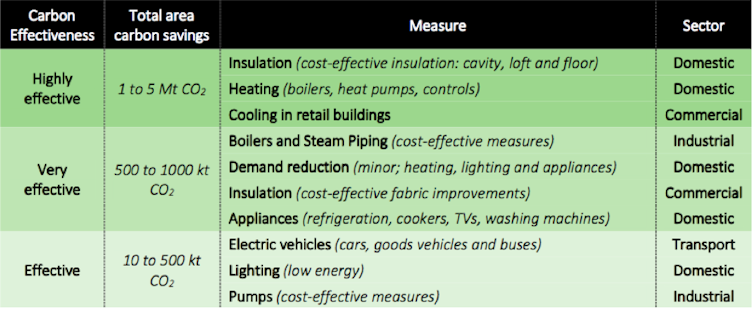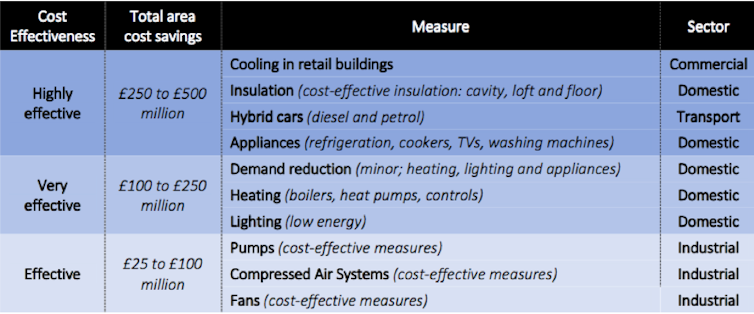National governments have historically led efforts to address climate change; setting the targets, planning the actions and then succeeding (or often failing) to achieve climate action goals. But increasingly, local, city and regional authorities are stepping up to tackle the challenge. Municipal governments are setting climate targets; corporations, investors and pension funds are funding local initiatives; and communities and individuals are driving the shift to a lower-carbon future.
Local actions have the potential to save as much as £7bn each year across the 50 largest cities in the UK – that’s equivalent to £300 per year for every person in each of these cities – and create more than 90,000 years of extra employment. A range of measures could deliver striking savings for individual households (£2.3bn annually), schools, hospitals, offices and other non-residential buildings (£1.2bn annually) and industry (£510m annually).
With the assistance of Rafael Luviano Ortiz, our team at the University of Leeds have come up with emissions projections and action plans for every local authority, local enterprise partnership, region and country in the UK, to support further action from this diverse coalition of governments, business and citizens. This work has been carried out as part of the Can-Do Cities initiative – a model designed to be used by other cities and communities, to develop their own climate and energy strategies.
Huge potential
Our work shows that a wide range of actions can be taken to complement national policy and reduce emissions even further – all while delivering economic returns. Exploiting opportunities for climate action at a regional or local level could help cities to cut their greenhouse gas emissions by 23 per cent, over and above the reductions happening through measures that have been planned already.

Extra measures taken by cities can cut emissions even further. Image: Andrew Sudmant/University of Leeds/author provided.
What’s more, these measures can yield further social, economic and environmental benefits if they are effectively implemented. For instance, in Leeds, Yorkshire, investments in energy efficiency and retrofits in homes could reduce energy bills more than £80m pounds annually, helping the poorest households to afford to keep warm in the winter.
In London, investments in low-carbon industrial processes could save the entire industrial sector more than £161m annually, improving competitiveness and freeing up funds to hire new workers and invest in new technologies.
Meanwhile, in Birmingham, investments in commercial buildings, hospitals, schools and local shops to upgrade heating and cooling systems, appliances and lighting could save £46m annually, helping small business owners expand and public services improve. And in Glasgow, investments in low carbon actions across each of these sectors could generate 2,400 years of employment: the equivalent of 240 full-time jobs for ten years.
Priorities in order
To make this information readily accessible, the Can-Do Cities team have produced reports and generated league tables of the most cost and carbon-effective actions, revealing opportunities for low carbon investment for every locality, city or region in the UK. Below, you can see the league tables for Leeds.

The most effective ways of reducing carbon emissions for the city of Leeds. Image: Andrew Sudmant/University of Leeds/author provided.

The most cost-effective forms of climate action for the city of Leeds. Image: Andrew Sudmant/University of Leeds/author provided.
Of course, concerted efforts must to be made to actually realise these benefits. Significant investments are needed. In a typical local authority, the total cost of low carbon measures across all sectors is about 1 per cent of the Gross Value Added (GVA) each year, for the next ten years. Even though these measures provide financial returns, they would benefit from support from central government.
Actions also need to be coordinated: land-use and transport developments must be planned with neighbouring cities and regions, in order to maximise the benefits.
The need for climate action must be embedded in the decisions made by local governments, businesses and citizens. Homes and offices are rarely designed with climate change as a primary consideration, and the same goes for transport networks and industrial plants. But the types of buildings and roads constructed today will influence the level of emissions coming from communities far into the future.
Climate action needs to be sustained, while adapting to advances in technology, which promise to provide new ways of reducing emissions, and may significantly lower the cost of existing options. For example, the uptake of electric vehicles could have a dramatic impact on emissions, if prices continue to fall and the grid continues to become less reliant on energy from fossil fuels. And while batteries and small-scale renewables such as solar and wind power are still a relatively costly way to store and produce electricity, advances seem imminent.
![]() These kinds of changes don’t undercut social, economic or environmental development; in fact, they contribute towards it. The analysis from our Can-do Cities team shows that reducing emissions can often lead to more liveable homes, more productive offices, improved urban mobility, and financial savings for industry: just the sort of improvements which all cities are looking to achieve.
These kinds of changes don’t undercut social, economic or environmental development; in fact, they contribute towards it. The analysis from our Can-do Cities team shows that reducing emissions can often lead to more liveable homes, more productive offices, improved urban mobility, and financial savings for industry: just the sort of improvements which all cities are looking to achieve.
Andrew Sudmant, Research Fellow in the Economics of Climate Smart Cities research programme, University of Leeds; Andy Gouldson, Professor of Environmental Policy and Associate Pro-Vice-Chancellor (Interdisciplinary Research), University of Leeds, and Joel Millward-Hopkins, Post Doctoral Researcher in Sustainability, University of Leeds.
This article was originally published on The Conversation. Read the original article.






